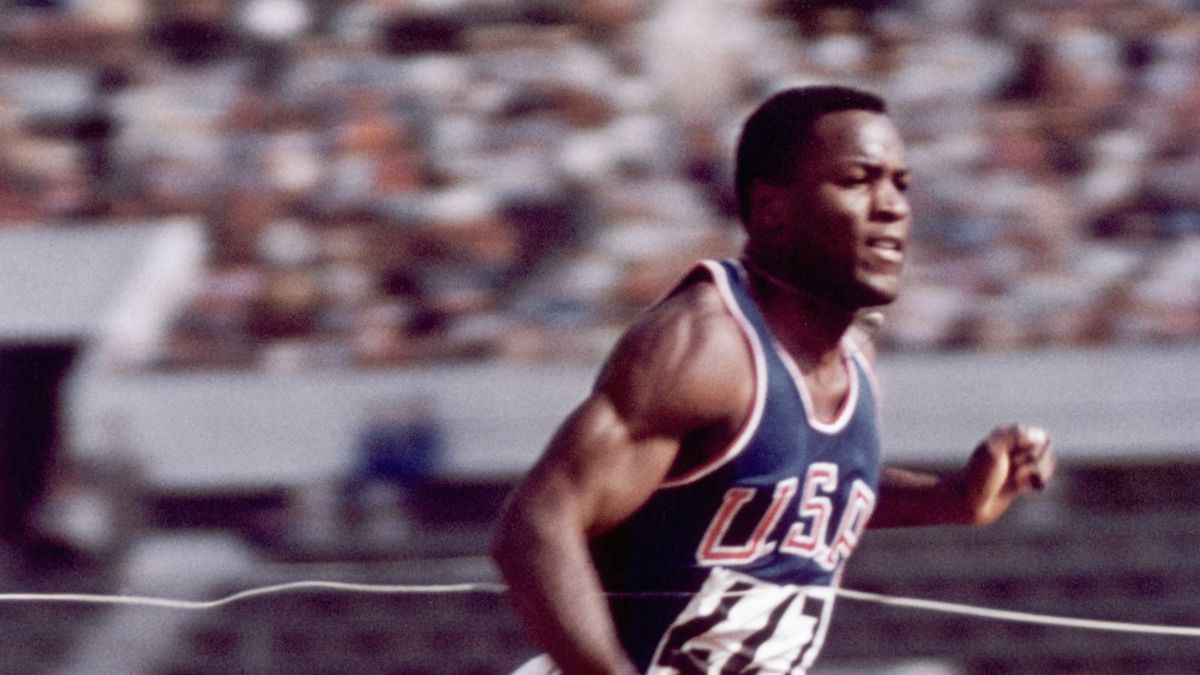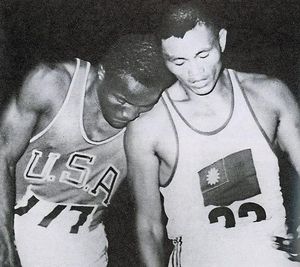It doesn't seem right to get upset about a great figure dying at age 86. But it also doesn't seem right to live in a world without Rafer Johnson.
Rafer Lewis Johnson was born on August 18, 1934 outside Dallas in Hillsboro, Texas. At the age of 9, he moved with his family to Kingsburg, California, outside Fresno. His younger brother Jimmy Johnson was a star cornerback at the University of California at Los Angeles (UCLA), and with the San Francisco 49ers, who retired his Number 37. He is a member of the Pro Football Hall of Fame, and is still alive at age 82.
In between the Johnson brothers at Kingsburg High School was Monte Clark, who also played for the 49ers, and won 3 NFL Championships: As an offensive tackle with the 1964 Cleveland Browns, and as the offensive line coach for the 1972 and '73 Miami Dolphins, winners of Super Bowls VII and VIII. He was head coach of the 49ers in 1976, and for the Detroit Lions from 1978 to 1984, winning an NFC Central Division title in 1983. He died in 2009. Tyler Bray, currently a backup quarterback for the Chicago Bears, is also a Kingsburg High graduate.
At that school, Rafer Johnson starred in football, basketball and baseball, and was elected class president. But his sport would be track and field. In 1952, his coach, Murl Dodson, drove him to nearby Tulare, to watch 1948 Olympic Gold Medalist Bob Mathias compete in the trials for the decathlon. Rafer told Dodson, "I could have beaten most of those guys." Not Mathias: He went on to become the 1st 2-time Olympic decathlon champion.
But Rafer won the event in the 1953 and 1954 California State Championships. That got the attention of Elvin C. "Ducky" Drake, the already-legendary track coach at UCLA. In only his 4th decathlon competition as a UCLA Bruin, Rafer broke the world record. In 1955, he won the Gold Medal at the Pan American Games, a Western Hemisphere "mini-Olympics," in Mexico City. Despite an injury, he managed to win the Silver Medal in the decathlon at the 1956 Olympics in Melbourne, Australia, behind another American, Milt Campbell of Plainfield, New Jersey.
Nearly 40 years later, Campbell would claim in an interview that he was not as celebrated as 1976 Olympic decathlon winner Bruce Jenner (now Caitlin Jenner), and he believed that racism was the reason. But Rafer Johnson, also black, was very much celebrated. The real difference was that Johnson would have something at Rome in 1960 that Campbell didn't have at Melbourne in 1956: Television coverage, to make people remember. Mathias, white, would likely have been forgotten as well had he only won the event once.
In 1958, Rafer broke another decathlon world record, and was named Sportsman of the Year by Sports Illustrated magazine, the 1st black person so honored.
But he had a new rival, in-house: Yang Chuan-Kwang of Taiwan, who was known as "C.K. Yang" in the American media, was also on the UCLA track team. As the 1960 Olympics in Rome, Italy approached, it was widely expected that they would finish 1st and 2nd in the decathlon, but the U.S. media, forced to cover a black American and an Asian non-American, weren't sure who would win. At least they tended to favor the American.Never before had there been 2 truly great contenders for the decathlon title, and there has only been one such buildup since, in 1992, when Dan O'Brien and Dave Johnson, both Americans, were much-hyped, but O'Brien messed up in the pole vault and didn't even make the Olympic Team, while Johnson "only" won the Bronze Medal. O'Brien tried again in 1996, and won the Gold.
The expectations for 1960 were met. For the Opening Ceremony, Rafer was chosen by the U.S. athletes to carry the flag, the 1st black person so honored -- and with Alaska and Hawaii having gained Statehood in 1959, this was the coming-out party before the world for the now-familiar 50-Star American Flag.
It was very hot in Rome for those 2 weeks, and pretty much every event not a sprint or a swim was considered an endurance event. And the decathlon is tougher than most. It takes place over 2 days, 5 events a day: The 100-meter dash, the long jump, the shot put, the high jump, the 400-meter run, the 110-meter high hurdles, the discus throw, the pole vault, the javelin throw, and the 1,500-meter run. So that's 4 runs (1 a hurdling event), 3 jumps and 3 throws. No wonder the Olympic Gold Medalist in the event, ever since Jim Thorpe won for America at Stockholm, Sweden in 1912, has been unofficially called "the world's greatest athlete."
And in 1960, the lead went back and forth between Johnson and Yang. After 9 events, Johnson was slightly ahead. But Yang had always run the 1,500 better than Johnson, so he was favored going into it. Drake was on hand, and gave each man conflicting advice: He told Johnson to stay close, and "be ready for a hellish sprint"; and he told Yang to get as far in front of Johnson as possible.
Yang won the event, but Johnson was only 1.2 seconds behind him. I don't know how the scoring system for the decathlon works, but the way it worked in 1960, Johnson's close 2nd was enough to give him the title by 58 points, 8,392 to 8,334 -- both totals ahead of the previous Olympic record. Someone snapped a picture of the two of them at the end, leaning on each other for support.
Rafer had also played basketball, for coach John Wooden, before Wooden began what became known as the UCLA dynasty with a Final Four berth in 1962 and the 1st of 10 National Championships in 1964. Wooden lauded Rafer for his defense, but, years later, wondered what he could have done if he had allowed Rafer to participate in what became known as the fast break.
Rafer was drafted by his "hometown" Los Angeles Rams in 1959, as a running back. But with his decathlon Gold Medal, his athletic career came to an end. This was before Bob Hayes, the 1964 100-meter Gold Medalist, got drafted by the Dallas Cowboys, leading many football teams to draft track stars, forgetting that running fast on a track and running with a football (and maybe trying to catch one first) while defenders are targeting you are two very different skills.
With UCLA's "Westwood" campus being a short distance from the Hollywood studios, Rafer wanted to go into acting. In the leadup to the 1960 Olympics, Kirk Douglas was making the historical epic Spartacus. There was a part for an Ethiopian gladiator named Draba, who defeats Spartacus (whom Douglas would play) in the ring, but refuses to kill him, out of a sense of honor, and is killed by the Roman authorities as punishment.
Rafer got the part, but was told by the Amateur Athletic Union that it would make him "a professional," and ineligible for the Olympics. In other words, under the rules of the time, if a collegiate athlete had any job at all, he couldn't compete in the Olympics. It was a stupid rule, but it was in place, and Rafer had to back out. Another great UCLA athlete, former football player Woody Strode, got the role instead.
The AAU did give him the James E. Sullivan Award, which they give to the nation's top amateur athlete, in 1960, making him the 1st black recipient. Finally allowed by the AAU to turn to acting, he made 9 films over the next 10 years, the best-remembered being None But the Brave, in 1965, a World War II-themed film with Frank Sinatra. He also became the weekend sports anchor for KNBC-Channel 4 in Los Angeles, but, like his hero Jackie Robinson, and his contemporaries Mickey Mantle and Sandy Koufax, wasn't comfortable as a sportscaster, and left the job.
In 1961, President John F. Kennedy gave his a job in the State Department. Remaining friendly, with the Kennedy family, he helped JFK's sister Eunice Kennedy Shriver found the Special Olympics, becoming the 1st director of the California edition.
In 1968, he worked on the Presidential campaign of JFK's brother, Senator Robert F. Kennedy. He and former Los Angeles Rams defensive tackle Rosie Grier, who had also turned to acting, were with RFK at the Ambassador Hotel in Los Angeles when he claimed victory in the California Primary, but was shot moments later. Johnson and Grier managed to tackle Sirhan Sirhan, the apparent assassin. One witness recalled hearing someone yell, "Rafer, get the fucking gun!"
In 1971, Rafer married Elizabeth Thorsen. They had 2 children, both of whom followed him into UCLA athletics: Joshua was a medalist in the javelin throw at the USA Outdoor Track and Field Championships, and Jennifer played volleyball, competing in beach volleyball at the 2000 Olympics in Sydney, Australia. Rafer and Elizabeth had 4 grandchildren.
In 1983, Rafer was elected President of the Board of Directors for the Special Olympics, serving until 1992. It was because of this, as much as his own athlete achievements, that he was selected to be the final torchbearer for the relay of the Olympic Torch, lighting the cauldron at the Los Angeles Memorial Coliseum at the 1984 Olympics.
In 1998, ESPN named him to its 100 Greatest North American Athletes of the 20th Century. In 2006, in celebration of its 100th Anniversary, the NCAA named him to its 100 Most Influential Student Athletes. In 2009, Arnold Schwarzenegger, then Governor of California -- and also then married to Eunice's daughter Maria Shriver -- named him to the California Hall of Fame. His former junior high school in Kingsburg was renamed for him.
Rafer Johnson died this Wednesday, December 2, 2020, following a stroke. He was 86 years old.
With his death, the earliest living Sports Illustrated Sportsperson of the Year is Jerry Lucas, the Basketball Hall-of-Famer who won it in 1960. There were already 3 earlier winners of the James E. Sullivan Award still alive: Figure skater Dick Button in 1949, pole vaulter Bob Richards in 1951 (one of the decathlon competitors defeated by Milt Campbell and Rafer Johnson in the 1956 Olympics), and diver Pat McCormick in 1956.







1 comment:
SLIGHT ERRORS FOUND IN FOLLOWING SENTENCE IN YOUR MOST INFORMATIVE RAFER JOHNSON TRIBUTE - CM
In 1961, President John F. Kennedy gave { his } a job in the State Department. Remaining friendly, with the Kennedy family, he helped JFK's sister Eunice Kennedy Shriver found the Special Olympics, becoming the { 1st } director of the California edition.
{ his } SHOULD BE ' him '
ALSO, ' 1st' SHOULD MORE CORRECTLY BE WRITTEN AS ' first '
Post a Comment